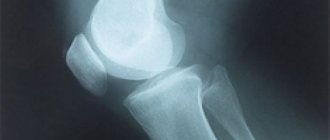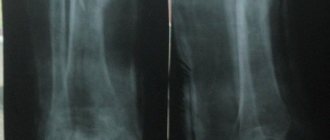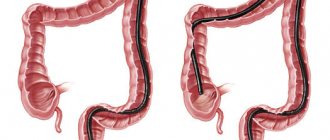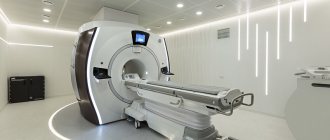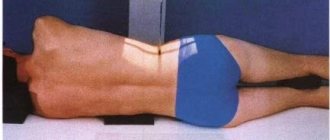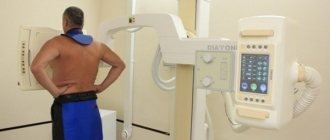1.What is irrigoscopy and why is it performed?
Colonic irrigoscopy is a special name for x-rays of the colon. Intestinal irrigoscopy is used to diagnose colon diseases
and other problems. To make the colon better visible on an x-ray, it is filled with a contrast agent, a barium suspension. Barium blocks X-rays and the picture is much clearer.
There are two types of colon x-ray:
Conventional irrigoscopy.
The colon is filled with a barium solution, which helps find large abnormalities.
Irrigoscopy with double contrast.
The walls of the rectum are covered with a thick layer of contrast material. The colon is then filled with air and “inflated.” This allows you to see smaller intestinal problems.
Double contrast irrigoscopy is used in cases where the conventional one did not help detect the problem.
Why is irrigoscopy done?
An X-ray of the colon can reveal:
- Inflammation of the walls of the colon, which appears with ulcerative colitis and Crohn's disease (granulomatous disease);
- Strictures and diverticula in the intestinal walls;
- Intussusception in children;
- The cause of symptoms such as abdominal pain, blood in the stool, or changes in bowel habits.
A must read! Help with treatment and hospitalization!
Purpose of the procedure
With the help of an examination, the diagnosis is clarified, the location of neoplasms (tumor process, polyps, diverticulitis) is determined, the condition of the mucous tissue is assessed, ulcers, atrophied areas, structural features of the intestine are identified, and the functional state of the organ is studied (atony, spasms).
Barium sulfate and a water-soluble iodine-based contrast agent can be used as a contrast agent (image quality below). Contrast is injected directly into the rectum (enema) or orally 12 hours before the test. How contrast should be administered depends on the diagnostic purposes.
In order to better see the mucous tissue of the lower intestines, contrast must be administered through an enema rather than orally. When contrast is taken orally, barium covers the walls of not only the large but also the small intestine, which makes it impossible to see whether the valve between the large and small intestines is functioning, and the walls of the organ are not stretched, therefore, the images are less informative.
With simple contrast, a barium sulfate solution is injected, and with double contrast, air is additionally introduced using a Bobrov apparatus. The air stretches the intestines, the walls of which are covered with a suspension of barium, which allows you to study the relief of the mucous tissue in more detail and see formations that remained invisible with simple contrast.
Double contrast is informative if the presence of neoplasms is suspected
The advantage of irrigoscopy over colonoscopy is that changes are visualized in the folds of the intestine that are inaccessible to the colonoscope (behind the folds of the mucosa, in the area of the bend of the colon, in the tortuous sigmoid colon). Thanks to this, you can consider all the features of the anatomy of the large intestine. In addition, the method allows you to assess the location and size of the large intestine and its functional features.
No ads 1
Unlike colonoscopy, the method is less traumatic and less likely to lead to complications. Irrigoscopy is not an alternative to colonoscopy, since only with the help of a colonoscope can you examine the large intestine in detail and, if necessary, take material for histological examination or remove a pathological formation.
2. Preparation for the procedure and how is it carried out?
Preparation for irrigoscopy
When preparing for a barium enema, be sure to tell your doctor if:
- you are allergic to latex or barium;
- You are pregnant;
- You have recently had a barium x-ray of your upper intestine, a colonoscopy, or a proctosigmoidoscopy.
When preparing for irrigoscopy, you should also know that it is necessary to completely clear the large intestine of stool and gas, because even a small amount can spoil x-rays.
You will have to not eat any food other than broths 2-3 days before the colon x-ray
. The day before barium enema, you need to drink plenty of clean liquids, take a laxative and do an enema with clean water. On the day of the colon x-ray, you may need to do the enema again.
How is irrigoscopy performed?
To x-ray the colon, it is necessary to fill it with barium solution. The barium suspension helps make the X-ray image clearer.
After your colon is filled, you will lie on a special table. The doctor will watch the barium solution move through your intestines on an X-ray fluoroscope screen. You may be asked to change positions so the contrast agent can penetrate deeper. Sometimes the doctor may also perform manual manipulation on your abdomen. If you have a double contrast barium enema, the barium will be removed from the colon and it will be filled with air.
After the rectal x-ray is completed, you will need to go to the toilet to get rid of excess barium. After this, the doctor will take a couple more x-rays.
Conventional fluoroscopy takes 30-45 minutes, although the time the barium suspension is inside is only 10-15 minutes. Irrigoscopy with double contrast takes about an hour.
Your stool may be white or pinkish for a day or two after the procedure. Drink as much fluid as possible to replace lost fluids.
Visit our Proctology page
Recommendations before manipulation
Two days before the test, it is recommended to drink plenty of fluids (up to 2 liters per day) and avoid foods that cause gas or take a long time to digest (vegetables, fruits, milk, potatoes, baked goods and bread, fatty meats).

To prevent the large intestine from becoming full of stool before the test, you must refrain from eating for 18–20 hours before the test.
Preparation for intestinal irrigoscopy includes cleansing the gastrointestinal tract of feces. Remains of feces impair the view of mucous tissue, which can affect the information content and accuracy of the study, so you must carefully follow the doctor’s recommendations for preparing for the study. You can prepare the intestines for diagnosis using the following methods:
- use of pharmaceuticals;
- administering an enema;
- after undergoing a colon hydrotherapy session.
The doctor will tell you which method is suitable in each specific case during a preliminary consultation. The use of laxatives is recommended for patients with ulcerative colitis or diverticulitis, since enemas are contraindicated for them.
[node:field_field_doprekl2]
Taking Fortrans
To cleanse the intestines, you need to drink 3-4 liters of water with a diluted drug. One sachet of Fortrans is mixed in a liter of water and drunk in several doses. To improve the taste, you can add lemon juice or other juice to the product, but without pulp.
The first liter of liquid should be drunk at approximately 16-17 hours, the second at 17-18 hours, and the third before 19 hours. The laxative begins to work within an hour after taking the first dose and lasts for another 3-5 hours after the last dose. After cleansing, you can only drink juice, tea, broth.
The laxative is contraindicated in the presence of an allergy to the components of the drug, in cases of dehydration, heart failure, perforation or risk of perforation of the gastrointestinal tract, in patients with a tendency to intestinal obstruction. Also, the drug is not recommended for children under 15 years of age, since there is no information about the effect of the drug on the children's body.
Cleansing enema
The procedure is not recommended if there are ulcers, erosions, cracks, or inflammation in the large intestine. You should also not do an enema if there is a tumor, hemorrhoids or rectal prolapse, with uterine or gastrointestinal bleeding, with constipation with severe pain in the lower abdomen. Thus, bowel cleansing is also contraindicated in case of heart failure.
To cleanse the intestines, use ordinary boiled water at a temperature of about 36 ⁰C. During one procedure, about 1–1.5 liters of water are poured. Two cleansing enemas are done the night before with an interval of 3 hours and two before irrigoscopy. The criterion for sufficient bowel cleansing is clean washing water.
Colon hydrotherapy
This procedure is carried out in the proctology department before irrigoscopy. Colon lavage is done using special equipment. The large intestine is repeatedly filled with water through a plastic tube, the liquid spreads throughout all sections and exits with the contents of the intestine through another tube.
About 20–30 liters of water are used per procedure. The pressure in the intestines does not exceed 100 millibars, which allows you to cleanse the intestines in a gentle way. The cleansing process is monitored on a monitor. The duration of the procedure is 25–45 minutes.
3.Risks of intestinal irrigoscopy
Risks of intestinal irrigoscopy
There is a very low chance of complications associated with rectal x-rays. Among them:
- Constipation caused by residual barium suspension;
- Inflammation called barium granuloma;
- Perforation from air pressure or barium suspension is the rarest, but most dangerous of the possible complications. This may occur if you have weak intestinal walls.
Tell your doctor immediately if you have anorectal bleeding, severe abdominal pain, fever, or no bowel movements for several days after the procedure.
About our clinic Chistye Prudy metro station Medintercom page!
Rules for collecting urine for general analysis
Urine for testing must be collected correctly to ensure accurate and accurate diagnostic data. Incorrectly collected urine cannot be analyzed adequately, so the result of the general analysis in this case is incorrect. Only correctly collected urine guarantees the correct analysis result.
To collect the required average portion of morning urine, you must adhere to the following collection method:
- Get up in the morning and immediately wash your external genitalia with warm water. Do not urinate before collecting urine for analysis!
- After washing, dry the perineum with a towel and sit comfortably in the bathtub, toilet or over the basin.
- Prepare a clean urine container by holding it in your right hand (or left hand for left-handed people).
- Release about a quarter of your urine into the toilet, bathtub, or basin, then hold your urine.
- Place the urine container near the urethra.
- Release about half more urine into the container.
- Remove the container with urine for analysis from the urethra.
- Release the last of your urine into the toilet, bathtub, or basin. The amount of urine for analysis must be at least 50 ml.
The collected urine should be submitted for analysis on the same day, within 2–3 hours. If you were unable to submit the collected urine to the laboratory, it is better to throw it away and collect another portion the next day. A clean urine container can be obtained from a laboratory or purchased at a pharmacy. Before collecting urine for a general analysis, strong physical activity, exposure to heat and cold, and taking medications should be avoided. Remember that obtaining the correct test result, which will help in diagnosing various diseases, is conditioned by following the rules for collecting urine.
Intestinal lavage (washing for cleansing) “Fortrans”
On the eve of the study, intestinal lavage is performed with a balanced electrolyte solution based on polyethylene glycol (Fortrans, Lavacol), which is an isosmotic solution that passes through the intestines without being absorbed or metabolized, as a result of which it is possible to avoid disturbances in the water-electrolyte balance and ensure effective intestinal lavage
It is traditionally believed that to achieve a cleansing effect, especially in patients with a body weight exceeding 70-80 kg, sufficiently large volumes (4 liters or more) of the drug are required. The dosage regimen is as follows: 2 liters in the evening and 2 liters in the morning on the day of the study. The first loose stool usually appears after consuming 1 liter of the drug, i.e. 1-2 hours from the start of taking the drug.
The Fortrans solution is prepared by dissolving a sachet of the drug in 1 liter of boiled and cooled water (and the Lavacol solution in 1 glass (200 ml) of drinking water). Over 1 hour, it is recommended to gradually and evenly - 1 glass (250 ml) per 15 minutes - drink a liter of the prepared solution. It is allowed to reduce the time of taking each liter of the drug to half an hour if it is well tolerated. It is recommended to drink the first two liters in the afternoon (if the study is scheduled for early morning hours) or in the evening (if the study is scheduled for daytime/evening hours) on the eve of the test. It is recommended to start taking the next two liters no less than 6 hours and no more than 10 hours before the scheduled time of the study, i.e. late in the evening the day before (if the study is scheduled for the early morning hours). The optimal time from the moment of taking the last dose of Fortransa to the start of the study is 4-8 hours (but not more than 11 hours). In most cases, the drug is well tolerated, but some patients do not take the entire dose due to poor taste and/or large volume of the drug. To overcome the idiosyncrasy to the taste of the drug, you can “wash down” the drug with a small amount of sweet tea with lemon juice, or add freshly squeezed lemon juice directly to the drug solution, and also suck on candies such as “Barberry”.


